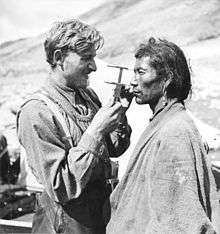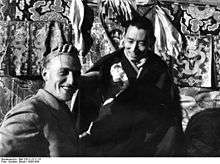Bruno Beger
| Bruno Beger | |
|---|---|
 Beger conducting anthropometric studies in Sikkim | |
| Born |
April 27, 1911 Frankfurt am Main, German Empire |
| Died |
October 12, 2009 (aged 98) Königstein im Taunus, Germany |
| Nationality | German |
| Alma mater | University of Jena |
| Occupation | Anthropologist, explorer, ethnologist |
| Known for | 1938–1939 German expedition to Tibet |
Bruno Beger (27 April 1911 – 12 October 2009) was a German racial anthropologist, ethnologist, and explorer who worked for the Ahnenerbe. In that role he participated in Ernst Schäfer's 1938 journey to Tibet, helped the Race and Settlement Office or SS-Rasse- und Siedlungshauptamt of the SS identify Jews, and later helped select human subjects to be killed to create an anatomical study collection of Jewish skeletons.
Early life

Beger was born in 1911 to an old Heidelberg family that soon after came upon hard times when Beger's father was killed in World War I, but a family friend paid for him to attend the University of Jena where he was first exposed to Hans F. K. Günther during a lecture, a man who would encourage him through his early academic career in anthropology and ethnology.
Service in the SS

In 1934, Beger began working a part-time job in the Race and Settlement Office of the SS where he eventually became a section head. Beger was asked to be part of an expedition to Hawaii, but while this was awaiting final approval, he was invited on a trip to Tibet led by Ernst Schäfer which he accepted instead.
In a proposal he wrote to Schäfer, Beger stated his contribution to the expedition would be "to study the current racial-anthropological situation through measurements, trait research, photography and moulds... and to collect material about the proportion, origins, significance and development of the Nordic race in this region."[1]
German Ernst Schäfer Tibet Expedition
All through the expedition, Beger kept a travel diary which was published in book form 60 years later, Mit der deutschen Tibetexpedition Ernst Schäfer 1938/39 nach Lhasa (Wiesbaden, 1998). Only 50 copies of it exist.[2]
Jewish skeleton collection
Beger worked together with August Hirt at the Reichsuniversität Straßburg. His assignment, which he carried out, was to provide the Nazi physician with detainees of diverse ethnic types from various concentration camps in order to serve Hirt's lethal racial experiments. The work involved selecting over 100 individuals from Auschwitz to be murdered for their skeletons. They were mainly Jews, and the crime was exposed during the Nuremberg trials in 1946 . The victims were sent to Natzweiler concentration camp for gassing by Joseph Kramer. Their corpses were then sent to Hirt in Strasburg. In these endeavours he was assisted by doctors Hans Endres, Hans Fleischhacker, Heinrich Rübel and Rudolf Trojan.[3]
After the war
In February 1948, Beger was classified as "exonerated" by a denazification tribunal unaware of his role in the skeleton collection.
In 1960, an investigation into the collection began in Ludwigsburg, and Beger was taken into custody on March 30, 1960. He was released four months later.
Nonetheless, the investigation continued until coming to trial on October 27, 1970. Beger claimed that he was unaware the Auschwitz prisoners he measured were to be killed. While two others indicted in the trial were released, Beger was convicted on April 6, 1971, and sentenced to three years in prison for being an accomplice in the murder of 86 Jews. Upon appeal however, his sentence was reduced to three years of probation. Neither of his colleagues with whom he was tried, Hans Fleischhacker and Wolf-Dietrich Wolff, were convicted.[4]
According to his family, Beger died in Königstein/Taunus on October 12, 2009.[5][6]
See also
Published work
- Meine Begenungen mit dem Ozean des Wissens, Kurt und Dieter Schwartz, Königstein, 1986, 11 pages. Broschüre zum 75. Geburtstag von Bruno Beger in einer Auflage von 250 Stück. OCLC 611195622.
- Mit der deutschen Tibetexpedition Ernst Schäfer 1938/39 nach Lhasa, Schwartz, Wiesbaden, 1998, 280 pages. Notes: Includes text of: Geheimnis Tibet: erster Bericht der Deutschen Tibet-Expedition Ernst Schäfer. München: Verlag F. Bruckmann, 1943. Contains an essay by Bruno Beger who was part of the expedition. Maps on lining papers. Description: xxxi, 249 p. : ill. (some col.), col. maps; 26 cm. ISBN 9783935102353; 3935102356. OCLC Numbers: 660670280; 163817098.
- Czwienk, Jürgen, and Georg Graffe. 2004. Die Expeditionen der Nazis Abenteuer und Rassenwahn. Gescher: PolarFilm. Notes: Filmbericht, Deutschland 2004. - Extras: 2 Bonusfilme: Burma Road (41 Min.), China: 1932 - 1935 (15 Min.). Performer(s): Mit: Ernst Schäfer, Bruno Beger. Description: 1 DVD-Video (Ländercode 0, 50 + 56 Min.): s/w, Dolby digital stereo. 12 cm. Responsibility: ein Film von Jürgen Czwienk und Georg Graffe. ISBN 3937163476; 9783937163475. OCLC Number: 314606494.
- Beger, Bruno. 1964. Es war in Tibet: Erlebtes im Himalaya und in Tibet. Frankfurt: Akademie für das Graphische Gewerbe. Herstellung: Semesterarbeit von Friedrich Beger. OCLC 611114953.
- Beger, Bruno. 1941. Die Bevölkerung der altmärkischen Wische: eine rassenkundliche Untersuchung. @Berlin, Univ., Math.-Naturwiss. Fak., Diss., 1941. OCLC 252078607.
References
- ↑ Joseph Cummins, History's great untold stories: obscure events of lasting importance, Murdoch Books, 2006, p. 327.
- ↑ Detlev Rose, L’expédition allemande au Tibet de 1938-39, voyage scientifique ou quête de traces à motivation idéologique ? Archived 2008-11-20 at the Wayback Machine.: "Bruno BEGER, Mit der deutschen Tibetexpedition Ernst Schäfer 1938/39 nach Lhasa, Wiesbaden, 1998, page 6. Ce livre récapitule les notes du journal de voyage de Beger, réadaptées pour publication. Il n'a été tiré qu’à une cinquantaine d'exemplaires."
- ↑ Pringle, Heather (2006). The master plan : Himmler's scholars and the Holocaust (1 ed.). New York: Hyperion. p. 254. ISBN 0-7868-6886-4.
- ↑
- ↑ "Die Spur der Skelette (Mention of death in section labeled Auftrag erweitert)". Der Spiegel (in German). 1 June 2010. Retrieved 23 March 2016.
- ↑ Lang, Hans-Joachim. "The Perpetrators". The Names of the Numbers. Retrieved 23 March 2016.
Further reading
- Hale, Christopher. Himmler's Crusade: the True Story of the 1938 Nazi Expedition into Tibet Bantam, 2004. ISBN 978-0-553-81445-3
| Wikimedia Commons has media related to Bruno Beger. |